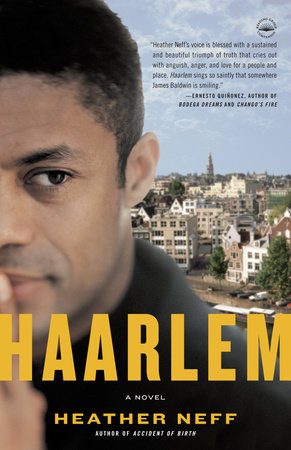Author Q&A
“Haarlem sings so saintly that somewhere James Baldwin is smiling.”
–Ernesto Quiñonez, author of Bodega Dreams
The author recently took some time to answer our questions about HAARLEM.
Black Ink: This book marks a departure for you from your earlier books like Wisdom and Accident of Birth. Can you tell us the motivation or impetus for this change?
Heather Neff: Like my earlier novels Blackgammon, Wisdom, and Accident of Birth, HAARLEM addresses themes that are extremely important in our swiftly changing world: notions of racial and sexual identity, confronting social inequalities in both our country and in other nations, and the responsibility of individuals to the people they love. My earlier works have been set in locales as far-ranging as Detroit, Paris, the Virgin Islands, and Liberia, West Africa. HAARLEM is, in its turn, equally divided between the Netherlands and New York, and attempts to comment on both cultures by virtue of comparison.
The protagonist of HAARLEM, however, lacks the self-confidence and sense of personal agency that have defined my earlier characters. Plagued by an impoverished and oftentimes abusive childhood, forty-five-year-old Abel Crofton is a blue-collar worker and recovering alcoholic who has spent much of his adult life struggling with sobriety. This ongoing challenge has dominated every aspect of his existence, keeping him in a state of near-emotional paralysis for years.
The story of Abel Crofton’s healing has given me the opportunity to focus on the finer and often-overlooked details of profound emotional trauma. Abel’s story is smaller in sweep than that of my earlier novels, but it makes up in intensity for what it surrenders in scope. The characters in HAARLEM are everyday people who are trying to survive in an often brutally uncaring world–and yet their stories are as painfully beautiful as any ever told.
BI: What connections will the reader find between Manhattan’s Harlem and Dutch Haarlem?
HN: In many ways both “Harlems” function as sites of spiritual and emotional nurturing for Abel. Despite having passed many difficult years in New York’s Harlem, Abel is aware that the city has provided him with a sense of cultural identity, racial pride, and social awareness.
It is thus the Harlem-bred man who arrives in the Netherlands, ready to discover how the Dutch Haarlem can affect his quest for wholeness. Indeed, the Old World Haarlem offers Abel an end to years of emotional exile from himself and from others.
BI: HAARLEM is obviously a work of fiction, but its themes of addiction and recovery resonate powerfully. Is there a stigma in the Black community against acknowledging addiction and entering recovery? If so, what is your purpose in addressing the issue in your fiction?
HN: Many artistic works view addicts as social “Others,” exiled from mainstream culture and lost to their families and communities. In HAARLEM I hope to shed some insight into the hearts and minds of all people–regardless of race–who are fighting addiction, in the hope that we will make the effort to educate ourselves and offer support to those in need.
BI: What is the import of racial identity in HAARLEM, and how do those notions of identity differ among the main characters?
HN: Concepts of racial identity are often defined by geographic borders. Abel Crofton’s understanding of himself as an African American male gains a new resonance as he meets other Blacks in the Netherlands and begins to recognize different notions of racial identity. For example, Sophie and Saskia, whose ancestry is a mix of African and East Indian, offer Abel a completely new understanding of what it means to be Black living in Europe.
BI: How do biblical archetypes operate in HAARLEM?
HN: HAARLEM looks specifically at two biblical stories dealing with the tensions that divide brothers–the Old Testament story of Cain and Abel (Genesis 4:1-16), and the New Testament tale of the Prodigal Son (Luke 15:11-32). Both of these stories reflect on issues that are still relevant to modern life: sibling rivalry, the need to please a father perceived as omnipotent, and the dangers of straying into sensual temptation. The central question raised by HAARLEM is whether Abel Crofton will respond to these situations in a different manner from his archetypical prototypes.
























